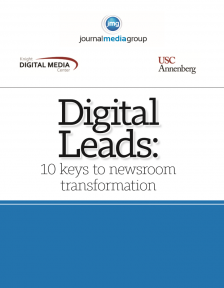Leadership and culture are linchpins of digital transformation in the newsroom

Little has proven more challenging for newspaper newsrooms than their transformation to digital news and information providers. It takes much more than learning new skills, although those are important.
It’s a matter of re-engineering journalists’ attitudes and their relationships with news consumers, as well changing newsroom workflows and priorities. It takes significant culture change; both leaders and staff must shift how they approach their roles.
In our work at Knight Digital Media Center (KDMC) helping newsrooms transform, we have learned the importance of a variety of factors, including having and articulating a clear strategy, an understanding of audience news consumption, training, and adoption of simple tools. These factors are detailed in a new report, “Digital leads: 10 keys to newsroom transformation.”
All 10 factors are important. But ultimately, leadership that creates an open, adaptive culture and fosters staff buy-in of change is the linchpin of transformation.
Working with news organizations in 13 markets (previously part of E.W. Scripps, now part of the Journal Media Group), Knight Digital Media Center at USC Annenberg developed a process designed to facilitate newsroom transformation.
The effort was designed to support implementation of the company’s Four Platform Newsroom strategy, which was led by Mizell Stewart III, an experienced news executive with corporate roles at both Scripps and now Journal Media Group. The multiyear effort, which began in 2012, has achieved results. The newsrooms have either achieved or are close to achieving a “digital leads” footing in which they focus on journalism for phones, Web and tablets and then produce a print newspaper at the end of the cycle.
The transformation is not finished. However, as the title of the report indicates, we consistently saw 10 elements present in newsrooms that were quick to embrace the initiative and produce results. Here are the 10 elements from the report:
- Strategy: The initiative was grounded in an overarching corporate strategy for multiplatform journalism that set a high standard but was flexible enough to evolve and to be adapted by each newsroom.
- Research: The company provided local consumer research to help newsrooms identify potential topics of high interest to target groups who wanted their news and information on digital platforms.
- Staff ownership: To foster staff ownership of changes, newsroom leaders appointed staff committees to determine key coverage priorities based on the research.
- Process and planning: Creating a consumer-focused newsroom culture was critical, so the KDMC process was designed to connect journalists with digital news consumers.
- Leadership and culture: Corporate and newsroom leaders kept up a steady flow of clear, consistent communication about the initiative, and facilitated staff ownership.
- Organization-wide buy-in: Newsroom leaders and committees made sure key people on the business side understood and supported changes in coverage.
- Training and tools: The initiative included KDMC and company training in digital strategy and literacy as well as skills training, relying heavily on free or low-cost training as well as peer learning.
- Organizational change: As newsrooms began to implement their digital initiatives, they altered their organizational structures, workflows, job roles and other internal practices to meet the new priorities.
- Priorities: Editors relentlessly looked for ways to cut traditional coverage to free resources for more compelling digital work.
- Feedback loops: Through Web and social metrics or by re-connecting with key audiences, newsroom teams assessed what was working and what was not.
The role that top newsroom editors played in the success of the initiative cannot be overstated. Without their willingness to step back and facilitate rather than acting as decision-makers, critical staff learning and buy-in would not have occurred.
Stewart acknowledged the challenge he was placing in front of his top editors by asking them to facilitate rather than direct. “It’s an unnatural role for an editor, there is no question. But I think it was critical in getting buy in of the organization.”
The more successful editors “made it very clear they were supportive of the process but had enough trust in their people to allow them to drive it. They were also savvy enough to choose the right people,“ he said.
KDMC guided the committees through a process designed to help them better understand digital audiences and connect with their news needs.
Stewart said the committees proved to be a key to getting the staff to embrace new ideas and practices. “The sense of ownership at the front lines really came from that,” he said.
That did not mean top editors were divorced from the effort. Far from it.
Guidance from the top editor contributed significantly to success of the committees. The more effective editors were active partners to the committees — communicating the strategy across the newsroom, providing support, time and other resources for the committees to do their work, and planning other changes as the initiative progressed.
Leadership communication also played a significant role. Relentless repetition of goals and direction and a willingness to drop print activities signaled the importance of the digital initiative.
In a handful of newsrooms, however, the process uncovered cultures of control and mistrust that had to be rebuilt under new leadership before significant work could go forward.
In these newsrooms, I observed two characteristics at work:
- The top editor or leadership circle tightly controlled activities and information. As a result, the staff members were afraid they might cross an invisible line or they did not know where they stood in terms of performance. This translated into a change-averse newsroom; change was just too risky for most of the staff.
- The top editor actively blamed someone else (often “corporate”) for the inability of the newsroom to move forward. This undermined the confidence of the staff that any changes or new efforts they proposed would be allowed to go forward.
Happily, nearly all of the top editors in the Four Platform effort embraced the process and their committees produced effective coverage plans.
“In newsrooms with a healthy culture, the process unleashed leadership at multiple levels,” Stewart said. However, “this process did not work in a broken newsroom culture. It revealed newsrooms that didn’t have a healthy culture. That was one of the most valuable parts of the process.”
This post is adapted from “Digital leads: 10 keys to newsroom transformation,’’ which I also wrote. It also originally appeared on the Community News Leadership 3.0 blog at Knight Digital Media Center at USC Annenberg.
